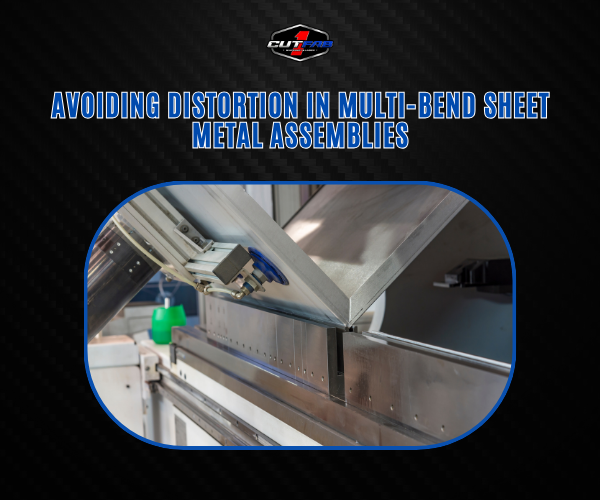
Avoiding Distortion in Multi-Bend Sheet Metal Assemblies!
Distortion is one of the biggest challenges in sheet metal fabrication. When metal is bent, stretched, or welded, internal stresses build up and cause unwanted warping. In multi-bend assemblies, these distortions don’t just affect appearance—they can compromise alignment, reduce strength, and drive up rework costs. That’s why mastering sheet metal distortion control is critical for engineers and manufacturers. By understanding why distortion occurs and how it impacts multi-bend designs, you can take proactive steps to minimize defects, ensure precision, and deliver reliable components every time.
Factors Causing Distortion
To achieve effective sheet metal distortion control, you first need to understand why distortion happens in the first place. In most multi-bend assemblies, distortion doesn’t come from one single source—it’s usually the result of several interrelated factors.
Springback is one of the most common culprits. After bending, the metal naturally tries to return to its original shape. This rebound can cause angles to be slightly off, especially in high-strength materials, leading to parts that don’t fit together as designed.
Uneven bending is another issue. If force isn’t applied consistently across the bend line, certain areas may stretch more than others. This uneven strain distribution creates warping, twisting, or dimensional inaccuracies that multiply when multiple bends are involved.
Then there’s residual stress—the hidden force left inside the metal after processes like cutting, forming, or welding. Residual stresses can release unpredictably during bending, making even precise operations produce distorted results.
By identifying these root causes, fabricators can choose the right corrective measures, from using proper tooling to refining bending sequences. The more you address these underlying factors, the more control you gain over distortion, ensuring multi-bend sheet metal assemblies remain accurate and cost-efficient.
Design Strategies to Reduce Distortion
Good design is the first line of defense when it comes to sheet metal distortion control. By planning bends and features with precision, you can dramatically reduce the risk of warping in multi-bend assemblies. Two strategies stand out: symmetrical bending and smart use of relief cuts with bend sequencing.
Symmetrical bending helps balance out the stresses in a part. When bends are placed evenly on both sides of a component, forces are distributed more uniformly. This reduces the chance of twisting or pulling the part out of alignment. Designers who adopt symmetry early in the process often find that their assemblies require less rework downstream.
Relief cuts and bend sequencing are another powerful way to control distortion. Relief cuts allow material to flow freely during bending, preventing excess stress from building up in concentrated areas. Meanwhile, carefully planning the order of bends—known as bend sequencing—ensures that each bend supports the next. Instead of fighting the natural springback, you guide it, making the final shape more accurate.
By combining symmetry, relief cuts, and logical bend sequences, engineers can transform distortion from a costly problem into a manageable factor. In short, smart design makes precision fabrication achievable.
Machine Settings and Tooling
Even the best-designed part can distort if machine settings and tooling aren’t properly optimized. For effective sheet metal distortion control, understanding how your press brake and dies interact with the material is essential.
Press brake tonnage plays a critical role. Applying too little force can result in incomplete bends, while too much can over-stress the metal, increasing the likelihood of springback or cracking. Calibrating tonnage based on material thickness, strength, and bend angle ensures consistent results across multiple bends.
Die selection is equally important. The right V-die width and punch radius reduce localized stress and help the metal flow smoothly during bending. Using mismatched dies can create uneven bends, twist, or residual stress, which compounds in multi-bend assemblies.
By carefully adjusting machine settings and selecting the correct tooling, fabricators can maintain tighter tolerances, reduce rework, and significantly improve the overall quality of multi-bend sheet metal parts. Proper setup is not just a step in production—it’s a proactive strategy in sheet metal distortion control.
Post-Bend Adjustments
Even with careful design and precise machine settings, minor distortions can occur after bending. That’s why post-bend adjustments are a critical part of sheet metal distortion control.
Straightening methods are commonly used to correct small warps or twists. Techniques like hand pressing, hydraulic straightening, or using a leveling press can restore parts to their intended shape. Choosing the right method depends on material thickness, bend complexity, and allowable tolerances. Consistent application prevents overcompensation, which can introduce new stresses or distortions.
Inspection checkpoints ensure that every part meets quality standards. Measuring angles, verifying dimensions, and checking alignment at multiple stages allows fabricators to catch issues early. Using tools like digital protractors, calipers, or laser measurement systems helps maintain precision, especially in multi-bend assemblies where small errors can accumulate.
By combining effective straightening with thorough inspection, manufacturers can reduce scrap, improve assembly fit, and deliver high-quality sheet metal components—making sheet metal distortion control a practical reality rather than just a design goal.
Conclusion
Preventing distortion in multi-bend sheet metal assemblies isn’t just about luck—it’s a combination of smart design, precise tooling, and careful post-bend handling. By understanding the causes of distortion, such as springback, uneven bending, and residual stress, engineers can implement proactive strategies to minimize defects.
Best practices for accurate assemblies include designing with symmetrical bends, using relief cuts, and sequencing bends logically to guide material flow. Equally important is selecting the right press brake tonnage and die configuration, which ensures consistent results across every part. After bending, effective straightening methods and thorough inspection checkpoints guarantee that minor distortions are corrected before final assembly.
Ultimately, mastering sheet metal distortion control saves time, reduces scrap, and ensures components meet strict tolerances. By combining design foresight, machine precision, and careful post-processing, manufacturers can produce high-quality, reliable multi-bend sheet metal assemblies—delivering both performance and efficiency in every project.
